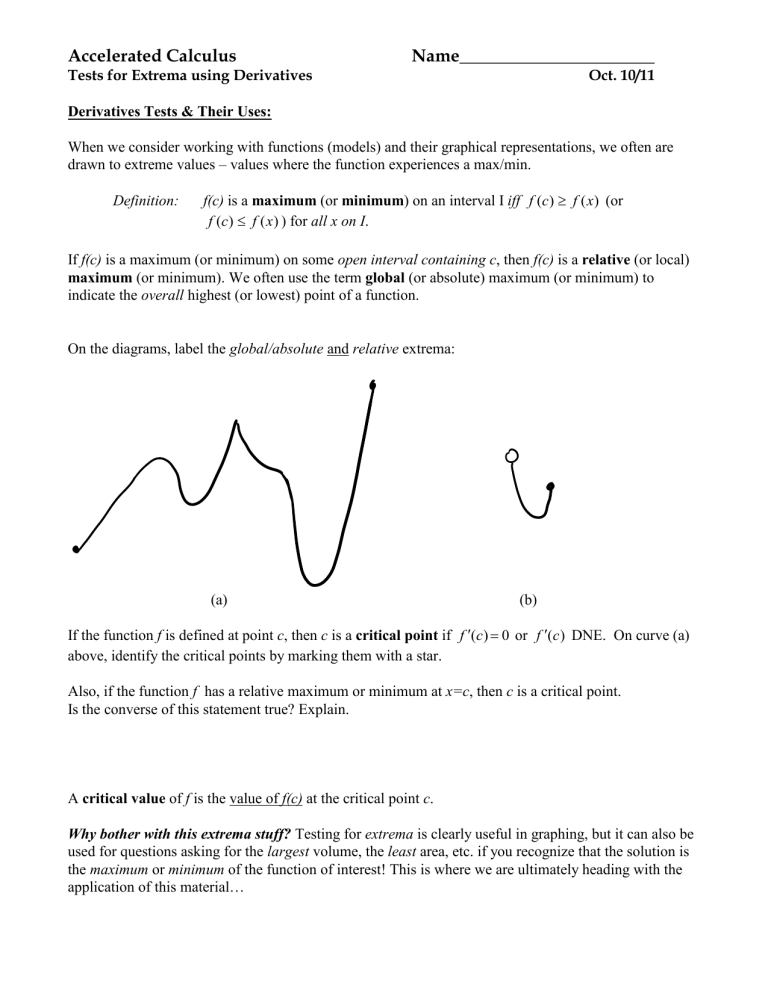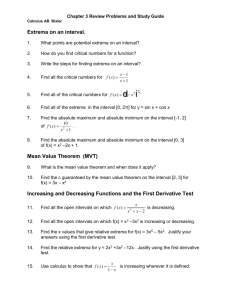Derivative Tests & Extrema

Accelerated Calculus
Tests for Extrema using Derivatives
Name______________________
Oct. 10/11
Derivatives Tests & Their Uses:
When we consider working with functions (models) and their graphical representations, we often are drawn to extreme values – values where the function experiences a max/min.
Definition: f(c) is a maximum (or minimum ) on an interval I iff ( )
( )
( )
( ) ) for all x on I .
(or
If f(c) is a maximum (or minimum) on some open interval containing c , then f(c) is a relative (or local) maximum (or minimum). We often use the term global (or absolute) maximum (or minimum) to indicate the overall highest (or lowest) point of a function.
On the diagrams, label the global/absolute and relative extrema:
(a) (b)
If the function f is defined at point c , then c is a critical point if ( )
0 or ( ) DNE. On curve (a) above, identify the critical points by marking them with a star.
Also, if the function f has a relative maximum or minimum at x=c , then c is a critical point.
Is the converse of this statement true? Explain.
A critical value of f is the value of f(c) at the critical point c .
Why bother with this extrema stuff?
Testing for extrema is clearly useful in graphing, but it can also be used for questions asking for the largest volume, the least area, etc. if you recognize that the solution is the maximum or minimum of the function of interest! This is where we are ultimately heading with the application of this material…
Accelerated Calculus
Example 1: ( )
x
3
3 x ( )
______________
Find the critical points of ( ) .
Using these critical points, we can construct this table:
Interval/Pt (
-1
Sign of ( )
(-1,1) 1
Q: From your table, can you tell which critical point(s) are maximum or minimum? Explain.
Sketch a graph of ( )
x
3
3 x , using y the information from the table you constructed.
x
You have just used the First Derivative Test to determine maximum and minimum points of a function!
The First Derivative Test : Suppose p is a critical point of a continuous function f .
If ( ) changes from negative to positive at point p , then the function attains a relative
__________________ at x
p .
If ( ) changes from positive to negative at point p, then the function attains a relative
__________________ at x
p .
Accelerated Calculus
( )
x
4
2 x
2
using the following questions as a guide. Example 2: Sketch the graph of
Q: Find the derivative:
( )
______________
Q: Find the critical points: x
______________
Using these critical points, construct a table (as done in the earlier exercise):
Q: From your table, can you tell which critical point(s) are maximum or minimum? Explain. y
Sketch a graph of ( )
x
4
2 x
2
, using the information from the table you constructed.
x
The graph of a differentiable function is said to be concave down on an interval where ( ) is decreasing, and concave up where ( ) is increasing. Visually, the graph is concave down if the graph is below the tangent line, and concave up if it is above.
Without graphing, how would you tell that ( ) is decreasing? increasing?
A point of inflection is where the concavity changes from up to down (or vice versa). How would you find (algebraically) the points of inflection?
Accelerated Calculus
This all brings us to The Second Derivative Test!
The Second Derivative Test : Suppose p is a critical point of a continuous function f .
If f
( )
0 AND f
( )
0 , then…
If f
( )
0 AND f
( )
0 , then…
If f
( )
0 AND f
( )
0 , then…
Note: A curve may have points of inflection, but no extrema on an interval…
Q: What is an example of a graph with a POI, but with no min/max?
Q: Sketch a continuous curve where there is a POI, but the function is not differentiable at that point.
Example 3: Analyze the function f x
3 x
5
5 x
3
completely (and clearly).
Your analysis should address the following:
Intercepts
Increasing vs decreasing intervals
Concavity intervals
Extrema & POI
Sketch of the function
y
Accelerated Calculus
x











